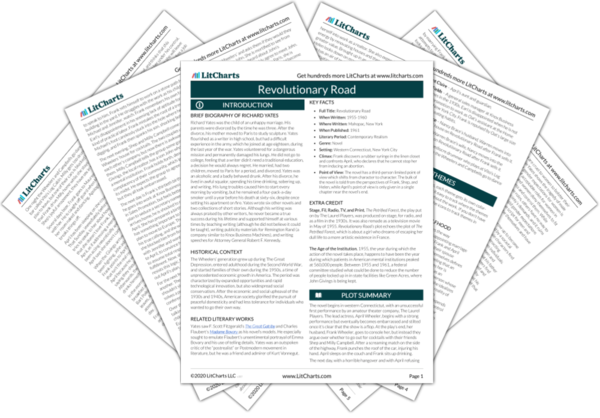Welcome to the LitCharts study guide on Richard Yates's Revolutionary Road. Created by the original team behind SparkNotes, LitCharts are the world's best literature guides.
Revolutionary Road: Introduction
Revolutionary Road: Plot Summary
Revolutionary Road: Detailed Summary & Analysis
Revolutionary Road: Themes
Revolutionary Road: Quotes
Revolutionary Road: Characters
Revolutionary Road: Symbols
Revolutionary Road: Theme Wheel
Brief Biography of Richard Yates

Historical Context of Revolutionary Road
Other Books Related to Revolutionary Road
- Full Title: Revolutionary Road
- When Written: 1955-1960
- Where Written: Mahopac, New York
- When Published: 1961
- Literary Period: Contemporary Realism
- Genre: Novel
- Setting: Western Connecticut, New York City
- Climax: Frank discovers a rubber syringe in the linen closet and confronts April, who declares that he cannot stop her from inducing an abortion.
- Point of View: The novel has a third-person limited point of view which shifts from character to character. The bulk of the novel is told from the perspectives of Frank, Shep, and Helen, while April’s point of view is only given in a single chapter near the novel’s end.
Extra Credit for Revolutionary Road
Stage, Fil, Radio, TV, and Print. The Petrified Forest, the play put on by The Laurel Players, was produced on stage, for radio, and as a film in the 1930s. It was also remade as a television movie in May of 1955. Revolutionary Road’s plot echoes the plot of The Petrified Forest, which is about a girl who dreams of escaping her dull life to a more artistic existence in France.
The Age of the Institution. 1955, the year during which the action of the novel takes place, happens to have been the year during which patients in American mental institutions peaked at 560,000 people. Between 1955 and 1961, a federal committee studied what could be done to reduce the number of people locked up in in state facilities like Green Acres, where John Givings is being kept.







